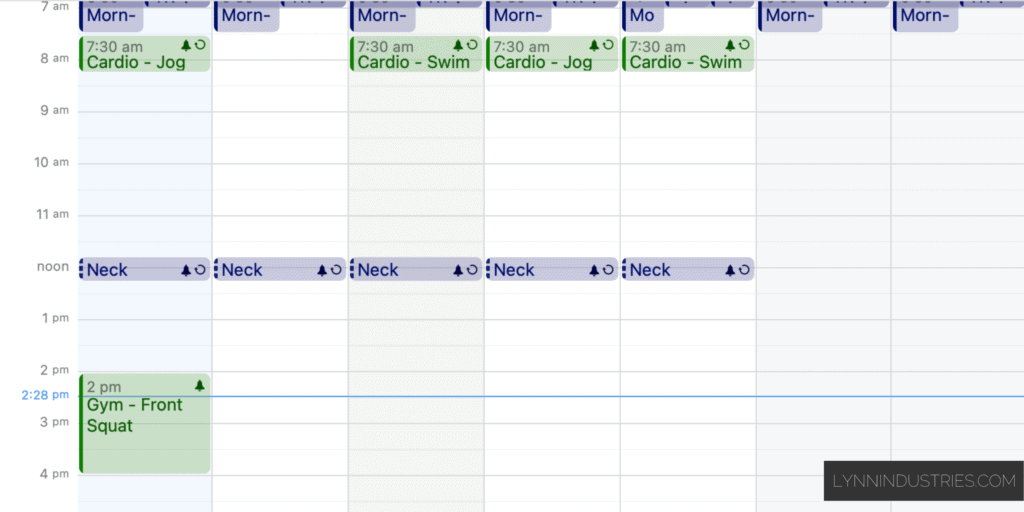
A while back a reader asked me how I track and implement habits.
Here’s the response I wrote back:
Hey reader,
I don’t use any habit tracking or streaks apps, but here’s how I currently implement habits:
I’d recommend purposefully engineering the order of habits you adopt. You want to go for the ones that give the most immediate rewards first. Exercise (endorphins) and morning rituals (good starts to the day) come to mind for me.
Once you’ve learnt the process from an easy-to-adopt habit, it becomes easier to tackle harder habits.
The mindset aspect is also helpful. Find out what your primary driver is and use it to your advantage.
For me it’s standards, specifically my own personal standards, so I would tell myself for example, that a productive person sleeps 8 hours a night and is up by 5am.
For others it may be something like status, so they would need to “brag” to others about how they’re part of the 5am club or always first in the office and show it off and use that to drive them.
I’m not a therapist but those two things together form cognitive-behavioural therapy of sorts which is probably why they work 🙂
Hope that helps!
Let’s break this down.
Why Not Use Habit Tracking or Streaks Apps?
I don’t use any habit tracking or streaks apps
For those unaware, habit tracking or streaks apps are from Jerry Seinfeld’s concept of “don’t break the chain”, where you do something daily and mark it off daily on your calendar to help you form a habit.
There’s nothing inherently wrong with the technique or the apps, I’ve just never seen the need to specifically use an app to track this.
I don’t believe that it’s that much more motivating to see a bunch of “X’s” crossed out on a calendar on my phone.
Pick One Habit Per Quarter

Pick one per quarter. Just one.
This goes back to JD Meier’s Agile Results.1Those were the days!
A major problem many people have is trying to do too many things at the same time.
What happens is very slow, minute progress is made on each thing.
This subjectively feels like NO progress is being made.
And so there is an insufficient action-reward mechanism in place, and the habit is not adopted.
My recommendation is to adopt one new habit per quarter.
Now that doesn’t seem like a lot and admittedly isn’t very exciting or Instagramable.
But done right, that’s four habits a year.
And if you select the right habits to adopt, is very beneficial for your life.
Habit Frequency
Figure out if it has to be done daily, weekly or whatever time period and note that.
Some habits you form in the support of goals.
Other habits are just “good for you”.
But the frequency with which you perform each habit is not the same.
For example, in your personal life, exercise might only be three times a week, while eating right would be daily.
In business, you might send outreach emails daily, but publish podcasts weekly.
Whatever the habit is, you need to work out the correct frequency beforehand.
Understanding the Habit via Information

Habit frequency is important but you need to know more than that to successfully form a habit.
The more you know about a habit, the more you increase the probability of successfully adopting it.
You need to know:
1. Habit technicals.
This is how to perform the mechanics of the habit properly, and will give you the peace of mind that you’re doing it correctly. It will also make sure that you’re receiving the full benefit from the habit, and that you’re not forming the wrong habit.
2. Rational reasons.
Knowing why the habit is rationally and logically “good for you” is extremely useful for motivation.
3. Emotional reasons.
Having non-rational, emotional reasons for adopting a habit in addition to the rational ones also helps motivation.
For example, “to make me look good to others”.2I use this simply as an example, not to advocate that you should care at all about what others think of you
You can gather information about your habit through:
- The general Internet, as a starting resource.
- Specialist coaches or gurus in certain areas.
For example if you want to know about productivity, personal development or managing businesses, read my articles.
If you want know about fitness and nutrition, read Andy Morgan’s site.
Use a Calendar To Track

Schedule it into the calendar as a reminder.
The most simple way to make sure that a habit is practiced every day is to put it on your calendar at a specific time, and do it at that time.
A calendar event with a reminder is a superior trigger to post-it notes, daily planners or even to-do lists.3The issue with a to-do list is that if gives you the option to do the habit at ANY time during the day, rather than a SPECIFIC time, which is better for habit formation.
This is because if you’ve set up your calendar correctly, it will trigger a notification on your computer, phone, or watch. And it’s guaranteed that you’ll be in front of and paying attention to one of those devices at any given time during the day.
More Complex Tracking
If some kind of complex tracking is needed I’ll make a Notion database and update it on my phone daily (or at the time period of the habit).
But what about if you need to track a more complex habit, where simply “I did it” isn’t enough?
An example of this would be tracking a morning ritual, where you want to know how you felt when you woke up, and then how you felt after your morning ritual was completed.
I recommend using something like a basic Notion database for this.
You could also set up a section in your daily journal entry templates.
Engineering the Order of Habit Adoption

I’d recommend purposefully engineering the order of habits you adopt. You want to go for the ones that give the most immediate rewards first. Exercise (endorphins) and morning rituals (good starts to the day) come to mind for me.
Because you are only adopting one habit per quarter, you want to engineer the order of habits so that you can see clear and immediate rewards.
This conditions you to realise that habits are good for you, and makes you more likely to continue to adopt future habits.
I would select the habits that have chemical or mood drivers.
Examples, as given, would be exercise and the resulting endorphins, or morning rituals and the “energised” feeling you experience after the ritual is complete.
Tackling Harder Habits
Once you’ve learnt the process from an easy-to-adopt habit, it becomes easier to tackle harder habits.
Some habits are harder to adopt than others.
An example of a harder habit to adopt would be “no snacking during the day”.
This is because:
- Snacking usually equals sugar which your body naturally craves.
- The motivational aspects are harder to see because you will rely on a mirror or scale to track “progress”, and that progress isn’t immediately obvious.
- There is no set time for this particular habit, it’s something you have to enforce all day.4And thus in this case, should go into your daily journal entry or on your to-do list.
For difficult habits like this one, I suggest having a few more immediate-reward habits successfully implemented first.
Before tackling one of these habits, gather as much information as you can to really understand how the habit works and fits together, and what variables can affect its successful implementation.
Mindset and Inner Game

The mindset aspect is also helpful. Find out what your primary driver is and use it to your advantage.
Handling your mindset and inner game when implementing habits means two things:
- Motivating yourself.
- Removing fear and obstacles.
You need to work out your primary driver for motivation, and this is different for everyone.
There is no right or wrong, but it is incredibly useful for you to know what yours is.
For example, it may be personal standards — do I measure up to my self-image?
It may be status — do I look like the shit?
The way to find this out is to do a core values discovery exercise. Your top value will be your primary driver for motivation.5If it isn’t, then you haven’t done the exercise correctly.
It can also be useful to remove any fear or obstacles that stand in the way of adopting a new habit.
This is because sometimes we can have the motivation and information and mechanics of a habit worked out, but there is simply a mental block preventing its successful implementation.
This could be a fear of worthiness, acceptance (from others), powerlessness or uncertainty.6Credit: Itamar Marani.
Dealing with these is simply a matter of identifying them, then performing some self-therapy to overcome them.
If the issue is worthiness, I recommend a perceptual positions exercise to rationally pick apart how silly it is.
If the issue is acceptance/caring what others think, read this.
If the issue is powerlessness or uncertainty, read up on Stoicism and your locus of control.
Other Considerations
Do I need external accountability to successfully implement a habit?
No, not unless external accountability is one of your drivers.
The reality is some people do well with external accountability, while others don’t.
There is no one-size-fits-all.
Should I “clear the path” with environmental reminders and triggers?
Absolutely.
An example of this would be setting out your gym clothes by the door or packed in a bag in the car the night before you go to the gym.
Should I create an artificial reward scheme to help reinforce the habit?
This is not necessary.
An example of this would be, “If I do this habit every day for a week, I can go out and have a nice meal”.
The reward of the habit itself should be enough of a reinforcement. Otherwise… why are you trying to form that particular habit?
What To Do Next


Habits are great.
Just remember:
- One habit at a time.
- Get all the information you need, especially the frequency.
- Use technology to help you track.
- Start with the right habits.
- Use mindset/inner game exercises to lay the groundwork.
- Clear environmental obstacles if needed.
- And…
There is more to optimising your life and performance beyond just habits.
In fact, habits are one small part of Flow.
If you want to change the way you look at habits and performance in your life, grab a free copy of Evolution below:
- Those were the days!
- I use this simply as an example, not to advocate that you should care at all about what others think of you.
- The issue with a to-do list is that if gives you the option to do the habit at ANY time during the day, rather than a SPECIFIC time, which is better for habit formation.
- And thus in this case, should go into your daily journal entry or on your to-do list.
- If it isn’t, then you haven’t done the exercise correctly.
- Credit: Itamar Marani.